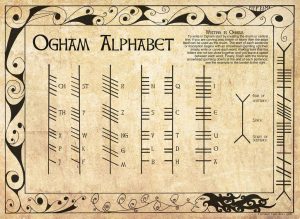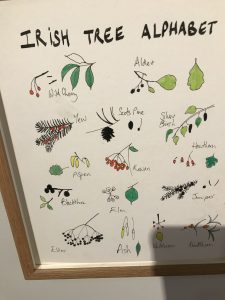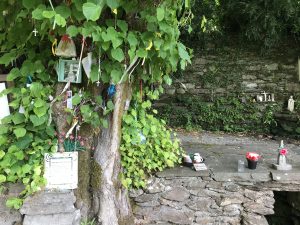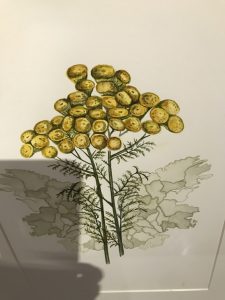8 Chapter Eight: Mythical Flora and Fauna
Flora as Symbols
“The land holds memories within it. This is a challenging idea to us now but it was pervasive in ancient thought. It is essentially an articulation of the soul of place” (Magan 152).
Original (Noble) trees of Ireland: Oak, Ash, Hazel, Birch, Scot’s Pine, Rowan, and Willow.
Ogham: B = Beit = Birch | F = Fearn = Elder | S = Sail = Sallow | Duir = Oak | C = Coll = Hazel | Onn = Ash

Niall Mac Coitir. Ireland’sTrees – Myths, Legends & Folklore. The Collins Press, 2003. EBSCOhost, https://search-ebscohost-com.libproxy.txstate.edu/login.aspx?direct=true&db=nlebk&AN=1008311&site=eds-live&scope=site.
Weave rushes for St. Brigid’s Day/Imbolc (i.e. St. Brigid’s cross)

St. Gobnait’s Well & tree
Bellanabriscaun -> Beal Atha na mBrioscan “the settlement of the ford of the wild tansy.” “A place like Bellanabriscaun would have received more covert night visits by women in distress, as tansy has long been used to induce miscarriages when taken in high doses” (Magan 140).

“Tansy” by Jennifer Trouton, Mater Natura: The Abortionist’s Garden
Foxglove: “Digitalis was proposed as the Latinised name for the plant in the 16th century by a German botanist, Leonard Fuchs (1501–66). Fuchs is German for ‘fox’. Apparently, he chose digitalis, a Latin way of saying ‘pertaining to the finger’, because the common German name for the plant is Fingerhut, which means, literally, ‘a finger hat’ or thimble’.” I much prefer the explanation offered by Davies and Hollman—the fairies gave the flowers to foxes to wear on their feet so they could move in magic silence towards hens or away from men.” -TSUNG O CHENG Professor of Medicine, Division of Cardiology, The George Washington University Medical Center, 2150 Pennsylvania Avenue NW, Washington, DC 20037, USA
Fauna as Symbols
Mythical Birds:
- “Cliodhna was drowned while hiding in the form of a wren to escape her progenitor, the principal sea god Mannanan, who wanted to do one of three things depending on which version you hear: take back her power, limit her freedom or crush the love she had for a young human, Ciabhan of the Curling Locks” (Magan 82).
- “Wrenboys still go out in Ireland on St. Stephens Day (English Boxing Day). The central theme of the wrenboy visit is the wren, an effigy of which is carried about in a holly branch or in a box or cage. Previously it was hunted and killed prior to St. Stephen’s Day and a matter of honour for groups to have a real bird. Source: https://www.sligoheritage.com/archwrenboys.htm
- The Garryduff Wren: https://archaeologyireland.ie/2018/03/02/the-garryduff-gold-bird/
- “When a native speaker uses the word badhbh for a hooded crow, there is in the word the memory of its earlier homonym, which refers to a female fairy who appears in phantom bird form to certain families” (Magan 110).
- The word badb is a generic term, signifying supernatural women, sometimes in the form of crows, who hover over the battlefield, foretelling the slaughter and later feeding on the slain” (Clark 225). In The Tain, Nemain and the Badb call out to the men of Ireland and a hundred warriors die of fright” (228). “A connection between Badb and the banshee seems likely; both are female spirits who prophesy death and destruction and terrify people with their fearsome howls” (226).
- The owl is sometimes referred to as cailleach oiche (‘the night witch’) and the cormorant sometimes called the cailleach dhubh (‘the black hag’)” (Magan 233).
- In Irish mythology, the goddess Badb features in the story of Táin Bó Cúailnge, taking on the form of a crow or raven as she causes terror amongst the forces of Queen Medb.
- Cranes were “believed by druids to carry the soul from one incarnation to the next. . . . They are depicted in the Book of Kells, and one is carved into an eight-century high cross in Co. Tipperary. . . . Their single open eye could stare directly into the Otherworld and . . . by standing on one leg, they could shift between worlds without being fully present in either. . . . Aife was transformed into a crane by a spurned lover. Late the sea god Mannan used her skin to make a crane bag to carry his most valuable treasures” (Magan 307-08).
- The children of Lir become swans when their stepmother becomes jealous of their father’s love for them.
*The eel is a symbol of the Celtic Otherworld (Tír na nÓg) deity/Formorian King Balar or Aedh.
*Salmon: The Salmon of Knowledge and Fionn Maccumhail (Finn McCool)
*Relevant to Sean O’Faolain’s “The Silence of the Valley”

